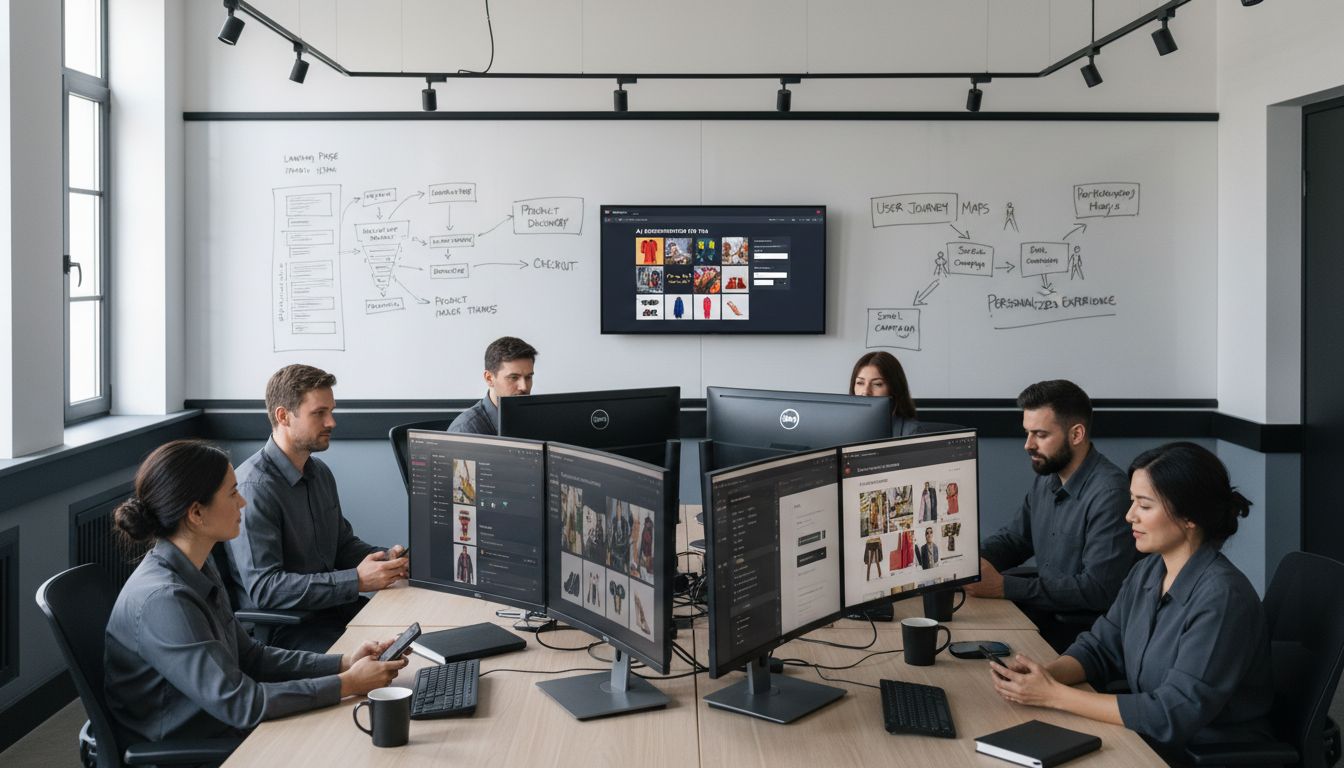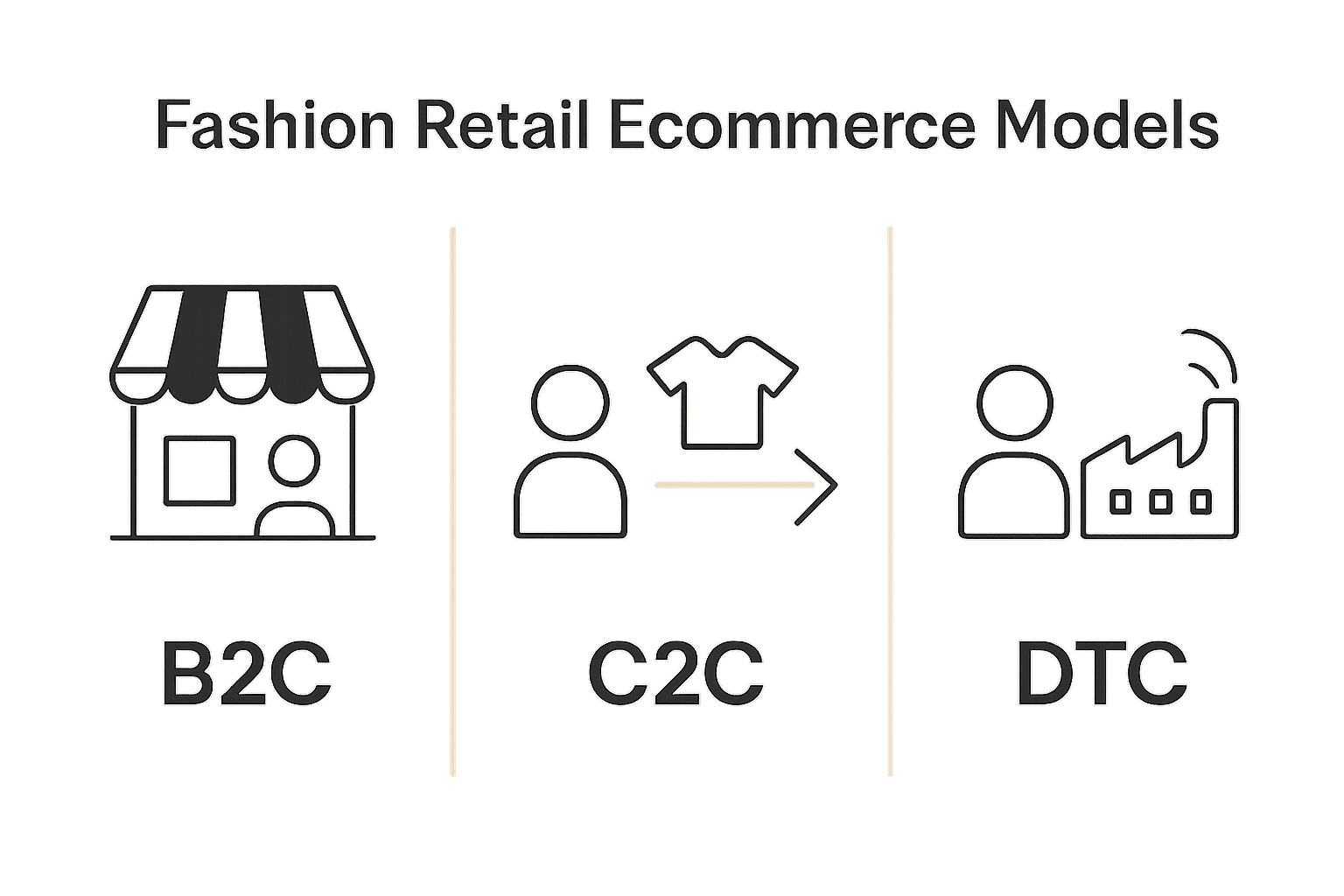
Online fashion retail now claims about 20 percent of all american ecommerce sales, a figure that keeps growing each year. The shift from browsing racks in stores to scrolling on screens has changed how people shop for clothing and accessories. With new technology shaping every step, from virtual try-ons to social media purchases, understanding today’s digital fashion landscape helps you make smarter choices and keeps you informed about the latest trends.
Table of Contents
- Defining Fashion Retail Ecommerce Today
- Key Components Of Fashion Ecommerce Stores
- Types Of Fashion Retail Ecommerce Models
- How The Online Fashion Store Works
- Critical Challenges And Success Factors
Key Takeaways
| Point | Details |
|---|---|
| Growth of Fashion Ecommerce | Fashion retail ecommerce now accounts for 20% of total online retail sales, projected to reach $219 billion by 2029. |
| Technological Integration | Modern fashion ecommerce platforms leverage AI and augmented reality to enhance user experience with features like virtual try-ons and personalized recommendations. |
| Diverse Business Models | Various ecommerce models, including B2C, C2C, and subscription services, have emerged, transforming the way consumers interact with fashion brands online. |
| Challenges for Success | Online fashion retailers face challenges like market competition and cybersecurity, emphasizing the need for innovative marketing and strong brand differentiation. |
Defining Fashion Retail Ecommerce Today
Fashion retail ecommerce represents the digital transformation of clothing and accessory sales, enabling consumers to purchase fashion items directly through online platforms. Online fashion retail has rapidly evolved from a niche market to a mainstream shopping experience, revolutionizing how people discover, select, and purchase clothing. Statista reports that this sector now accounts for approximately 20% of total online retail sales, with projected revenues expected to reach $219 billion by 2029.
The contemporary fashion ecommerce landscape goes far beyond simple transactional websites. Modern platforms integrate advanced technologies like personalized recommendations, virtual try-on features, and seamless social media shopping experiences. Shopify highlights how social commerce platforms like TikTok and Instagram have transformed product discovery, allowing shoppers to visualize fashion items through real-world influencer content and in-app purchasing.
Key characteristics of fashion retail ecommerce include:
- Instant global accessibility
- 24/7 shopping availability
- Diverse payment and shipping options
- Enhanced product visualization through high-resolution images and video
- Personalized shopping experiences powered by AI and machine learning
For fashion enthusiasts seeking a comprehensive understanding of online clothing retail, Why Shop Online for Apparel: Complete Essential Guide provides deeper insights into the evolving digital fashion marketplace.
Key Components of Fashion Ecommerce Stores
Successful fashion ecommerce stores are complex digital ecosystems designed to provide seamless, engaging shopping experiences. Olitt highlights several critical components that define modern online fashion retail, emphasizing the importance of a mobile-first design that caters to the growing number of smartphone shoppers. This approach ensures that websites are responsive, easily navigable, and visually appealing across multiple device types.
Technology plays a transformative role in contemporary fashion ecommerce platforms. Abbacus Technologies reveals how advanced technologies like AI and augmented reality are reshaping online shopping experiences. These innovations enable features such as:
- Virtual clothing try-on capabilities
- AI-powered outfit recommendations
- Personalized shopping experiences based on user preferences
- Body type-specific styling suggestions
- Real-time inventory and size matching
Key technical and design components of fashion ecommerce stores include robust security protocols, intuitive user interfaces, high-resolution product imagery, and multiple payment gateway integrations. Smooth checkout processes, transparent shipping information, and responsive customer support further enhance the overall shopping experience.
 For a deeper exploration of online fashion retail strategies, check out The Essential Guide to Ecommerce in Fashion, which offers comprehensive insights into building successful digital fashion platforms.
For a deeper exploration of online fashion retail strategies, check out The Essential Guide to Ecommerce in Fashion, which offers comprehensive insights into building successful digital fashion platforms.
Types of Fashion Retail Ecommerce Models
Fashion retail ecommerce has evolved to encompass diverse business models that transform how consumers discover, interact with, and purchase clothing online. Statista highlights two primary models: business-to-consumer (B2C) and consumer-to-consumer (C2C) platforms. B2C models, represented by brands like H&M and Zara, integrate physical and digital shopping experiences, allowing customers to browse and purchase through comprehensive online stores that mirror their in-store collections.
Digital marketplaces represent another sophisticated ecommerce model in fashion retail. Wikipedia illustrates this approach through platforms like Farfetch, which aggregate products from hundreds of brands, boutiques, and department stores worldwide. These platforms offer unique advantages such as:
- Extensive product diversity
- Access to global fashion brands
- Curated shopping experiences
- Simplified multi-brand purchasing
- Reduced geographical shopping limitations
Additional fashion retail ecommerce models include:

- Direct-to-consumer (DTC) brands
- Subscription-based fashion services
- Social commerce platforms
- Luxury brand digital storefronts
- Vintage and second-hand clothing marketplaces
For fashion enthusiasts interested in understanding contemporary style trends that intersect with these ecommerce models, Role of Trends in Fashion: Complete Essential Guide provides comprehensive insights into how digital platforms are reshaping fashion consumption.
How the Online Fashion Store Works
Online fashion stores represent sophisticated digital ecosystems that blend technology, user experience, and retail strategy to create seamless shopping experiences. Abbacus Technologies reveals the intricate mechanics behind these platforms, highlighting how advanced technologies like AI and augmented reality transform traditional shopping paradigms. These digital storefronts leverage complex recommendation engines that analyze user behavior, preferences, and historical data to curate personalized shopping journeys.
Olitt emphasizes the critical components that enable smooth online fashion retail operations. The core functionality involves multiple interconnected systems:
- Responsive mobile-first design
- High-resolution product visualization
- Secure payment processing
- Real-time inventory management
- Personalized user experience algorithms
The operational flow of an online fashion store typically follows a sophisticated sequence: customer browsing triggers personalized recommendations, selected items are added to a digital cart, user authentication and payment verification occur, and finally, inventory systems coordinate shipping and delivery. Advanced platforms integrate features like virtual try-on technologies, size recommendation algorithms, and instant customer support to enhance the shopping experience. For fashion enthusiasts seeking deeper insights into digital shopping trends, The Essential Guide to Social Media in Fashion offers comprehensive exploration of how social platforms are revolutionizing online retail interactions.
Critical Challenges and Success Factors
Fashion retail ecommerce faces a complex landscape of challenges and opportunities that demand strategic navigation. Neoberx highlights the critical obstacles confronting online fashion retailers, emphasizing that success hinges on addressing multifaceted challenges such as intense market competition, intricate return management, and robust cybersecurity protocols. Brands must develop distinctive identities and innovative marketing strategies to differentiate themselves in an increasingly saturated digital marketplace.
Shopify reveals that success factors in modern fashion ecommerce are deeply intertwined with technological innovation and social engagement. Key strategies include:
- Leveraging social commerce platforms
- Creating shoppable content
- Integrating seamless in-app purchasing experiences
- Developing platform-specific marketing approaches
- Utilizing influencer partnerships for product promotion
The most successful online fashion retailers understand that overcoming challenges requires a holistic approach. This involves continuous technological adaptation, understanding nuanced customer preferences, maintaining transparent communication, and creating personalized shopping experiences that transcend traditional retail boundaries. For fashion enthusiasts seeking deeper insights into navigating these complex dynamics, What are Bestsellers in Fashion? Understanding Their Appeal provides invaluable perspectives on consumer trends and market strategies.
Elevate Your Style with Confident Online Fashion Shopping
Understanding the challenges of fashion retail ecommerce shows how important personalized, seamless shopping experiences are. With issues like intense market competition and the need for standout digital platforms, finding an online store that combines trend-forward design and easy navigation can be difficult. If you want clothing that expresses your bold, unapologetic spirit while enjoying smooth checkout, flexible payments, and clear return policies, the right destination awaits.
Discover contemporary women’s collections that meet modern ecommerce expectations at Dark Femme. From striking dresses to chic jumpsuits and rompers, every piece empowers you to be unapologetically yourself.

Ready to embrace fashion retail ecommerce designed with you in mind Explore now at https://darkfemme.com where season sales and new arrivals offer the perfect opportunity to redefine your wardrobe with confidence and style.
Frequently Asked Questions
What is fashion retail ecommerce?
Fashion retail ecommerce refers to the online sale of clothing and accessories directly to consumers through digital platforms. It encompasses a variety of models, including business-to-consumer (B2C) and consumer-to-consumer (C2C).
How do advanced technologies impact online fashion shopping?
Advanced technologies like AI and augmented reality enhance online shopping experiences by offering personalized recommendations, virtual try-on capabilities, and tailored styling suggestions, making the purchase process more engaging and efficient.
What are the key components of a successful fashion ecommerce store?
Successful fashion ecommerce stores typically feature a mobile-first design, high-resolution product images, secure payments, real-time inventory management, and personalized shopping experiences to enhance user engagement and satisfaction.
What challenges do fashion retailers face in ecommerce?
Fashion retailers encounter challenges such as intense market competition, managing returns, ensuring cybersecurity, and differentiating their brand. Strategies to overcome these challenges often involve leveraging technology and engaging customers through social media.




